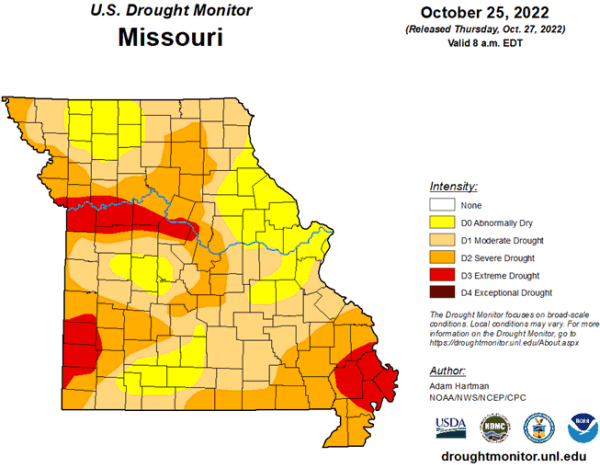
October 2022 Weather and Its Impacts on Missouri
Pat Guinan
State Climatologist
University of Missouri Extension
Pleasant autumn weather was the theme in October with high temperatures on most days reaching the 70's and 80's and only a handful of days below 60°F, Figure 1. Preliminary data indicate the statewide average October temperature was 56.1°F, or 0.9° below the long-term average. Four out the past five Octobers have been below average and it was the coolest October since 2020, Figure 2. It was the first below average month since April and fourth for the year, Figure 3.
The growing season effectively came to an end during the morning of 10/19 when temperatures dropped to the upper teens and lower 20's statewide, with the exception of the Bootheel where minimum temperatures ranged from the mid to upper 20s.
The statewide average preliminary precipitation total for October was 2.73 inches, or 0.46 inches below the long-term average. It was the first drier than average October in six years and driest since 2016, Figure 4. There have been four drier than average months this year, Figure 5.
According to radar estimates, above average rainfall occurred over much of east central and portions of southwestern Missouri where 3-5 inches were common, Figure 6. Lightest radar estimates were found across northern and southeastern Missouri where less than 2-inches were indicated.
According to the Missouri Agricultural Statistics Service, for the week ending October 30, corn and soybean harvest was 83% and 73% complete, respectively; 5 percentage points ahead of the 5-year average for corn and 17% points ahead the 5-year average for soybean. The topsoil moisture conditions were reported 0% surplus, 33% adequate, 40% short and 27% very short, whereas subsoil conditions were listed at 0% surplus, 26% adequate, 41% short and 33% very short. Hay supplies were 49% adequate, 39% short, 12% very short and 0% surplus. Stock water supplies were 44% adequate, 43% short, 13% very short and 0% surplus.
Dry fall conditions perpetuated existing livestock winter feed supply concerns. Cool season grass growth was poor due to lack of rainfall in September and the first three weeks of October. The mid-October hard freeze put an end to the growing season, and grass did not recover despite wetter conditions toward the end of the month. Severe to extreme drought was still impacting sizeable portions of Missouri according to the U.S. Drought Monitor during the last week of October, Figure 7.
A wildfire, sparked by a combine harvesting in a field, quickly grew out of control due to dry conditions and high winds, and ripped through the small central Missouri community of Wooldridge during the evening of October 22nd, Figure 8. The whole town was evacuated and about half the town was impacted, with twenty to twenty-five buildings burned or damaged, according to a spokesperson for the Cooper County Fire District. In addition, 3,000-3,500 acres were burned. Some people were treated for burns but no fatalities were reported.
Jump to:
- Figure 1
- Figure 2
- Figure 3
- Figure 4
- Figure 5
- Figure 6
- Figure 7
- Figure 8
- Figure 9
- Figure 10
- Figure 11
- Figure 12

Figure 1.

Figure 2.

Figure 3.

Figure 4.

Figure 5.

Figure 6.

Figure 7.

Picture taken Saturday, October 22, 2022, at the I-70 bridge near Rocheport, MO, looking west-southwest
toward Wooldridge, MO. Photo by: Matt Williams.
Figure 8.




Source: Pat Guinan, 573-882-5908












